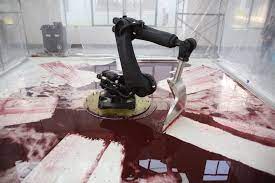Alexia Forsyth
15104
09/13/22
“Blooming” Fibonacci Zoetrope Sculptures by John Edmark
John Edmark’s “Blooming” Fibonacci is a beautiful floral display of 3D fabrication. His series is beautiful and inspiring. The amount of detail is truly spectacular to see in a 3D fabrication. Edmark has several pieces similar to the one below, each magical and awe-inspiring. According to the artist, the piece was inspired by the golden angle: everything is synchronized explicitly to the rate as the sculpture turns 137.5 degrees. Every petal is placed at a particular length from the center. It gives the appearance of petals moving: shifting outwards and shrinking at the corners. The 3D model spins at 550 RPMs and is videotaped at 24-frames-per-second. This creates a repeating optical effect. His artwork is special because it mimics phyllotaxis, the geometric arrangement of leaves on a plant stem.
![[OLD SEMESTER] 15-104 • Introduction to Computing for Creative Practice](https://courses.ideate.cmu.edu/15-104/f2022/wp-content/uploads/2023/09/stop-banner.png)





